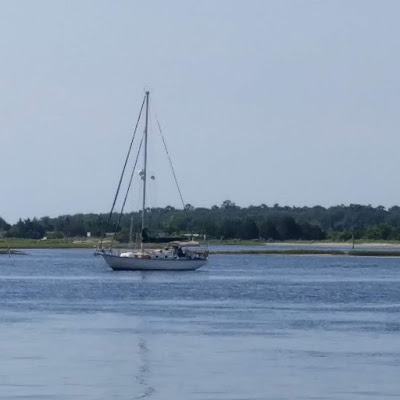[Hilde's log]
We’ve been at the
dock in New Bern, North Carolina, since my last post. We wondered how
the area had fared in our ten year absence, and to our delight we
discovered that it’s pretty much the same. New Bern is about 300
years old (founded in 1710) and maintains a vibrant and charming
downtown area. Its close-in residential areas are full of beautifully
kept old homes, many of which are priced so reasonably we could buy
one.
A trip down Broad Street in New Bern
New Bern sits at the junction of the Trent and Neuse Rivers, and so has a lot of beautiful waterfront and lots of area to sail when the wind is up (which it is not in July and August).
A trip down Broad Street in New Bern
New Bern sits at the junction of the Trent and Neuse Rivers, and so has a lot of beautiful waterfront and lots of area to sail when the wind is up (which it is not in July and August).
 |
| The town docks on the Neuse River, just off Union Point in New Barn. Free for 48 hours! And, unlike Oriental, you can actually get to them in a decent amount of water. |
 |
| A summer storm sweeps over the marina. It brought some cooler temperatures for a day or two, which was a big relief. |
David and I loved it here
when we lived here 10 years ago, and so we began to wonder...why not
move back? We’re retired, we can get a house, the area is centrally
located along the East Coast with beautiful sailing areas in close
reach. What’s not to like? We even went so far as to shop for
homes, looking near and far (a whole 10 miles away from downtown), at
new homes and old, big and small and in-between.
 |
| A glimpse of New Bern. The bear statues (to the right in this photo) are all over town, like the pelican statues in Seabrook. |
You know how
things can look really, really good on paper, but they just don’t
seem to work out? That has been our experience here. We couldn’t
find a home that was just right, or a neighborhood that was just
right, or a price that was just right. Either the house needed too much updating or it was too far from downtown or it was claustrophobic or too unique for resale or just too big to keep up and have any kind of life. It was very frustrating.
Regardless of the
house, we knew we wanted to have a car. That’s one of the most
frustrating aspects of cruising. When you get to shore, you are
stranded in the vast majority of places. You can get to any place
that’s within a couple of miles of the harbor simply by walking, or
you can beg or borrow or rent a car. It can be really frustrating to
run those necessary errands. So, since we had decided to stop until
fall (summer here is almost as bad as summer in Houston), we needed
wheels.
That was absolutely
no trouble at all! We found a local Hyundai dealership and actually
liked the folks working there. When has that ever been the case?
Never for me. We ended up with a new 2018 Hyundai Sonata for about
the same price I paid for my Acura Integra 20 years ago. No lie. I
keep waiting for the wheels to fall off, but so far, so good.
 |
| Check it out! Red! |
In the process of
buying the car, we discovered that our previous belief, that North Carolina does
not tax retirement income, was incorrect. North Carolina does not tax Social
Security income. It does tax IRA distributions and pensions,
at 5%. Talk about a cold shower! That put a halt to looking at homes
in a hurry.
So, we wondered, how
to alleviate some of the more irritating aspects of living on a boat
at the dock? One major irritant is feeling overcrowded. Spare parts,
project supplies, winter clothes in summer, winter shoes in
summer….all crowd the cupboards and lockers until I want to pull my
hair out some days. That was one of the draws of a house: being able
to unpack!
Since a house was
out, we decided to rent a small air conditioned storage unit for the
overflow. We drove out to a likely place on Sunday. It was
closed...but the owner saw us in the driveway and came over to chat.
Finding out what we were looking for, he told us he has one that had
come vacant the day before, opened the office and signed us up. As it turned out, it was the only one that size he had vacant.
One some levels, our
experience here has been a resounding “No” - as in, no house, no
you aren’t going to live here. On others, the experience has been
eerily easy: new car, no problems (in fact that’s what saved us
from making a very expensive mistake), storage space, no problem. I
get the feeling we are being gently herded...somewhere.
The current plan is to enjoy the A/C (when it is working) at the dock for July and August. In September we leave for England to visit David's mom. Then in October, when we return, we'll set off for the Chesapeake and some good sailing! Stay tuned.
Meanwhile, we have
been promised fireworks over the Trent River basin (just behind us in
the marina) on the 4th. I plan to sit out on the foredeck
with a cold can of seltzer and enjoy the show, heat or no heat.
Here’s wishing all of you a festive Fourth of July!












































